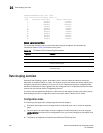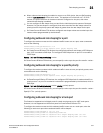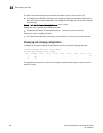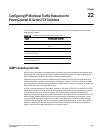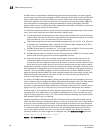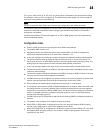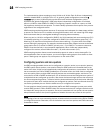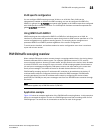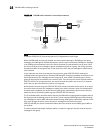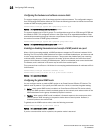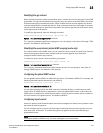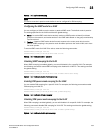
652 PowerConnect B-Series FCX Configuration Guide
53-1002266-01
IGMP snooping overview
22
The implementation allows snooping on some VLANs or all VLANs. Each VLAN can independently
enable or disable IGMP, or configure V2 or V3. In general, global configuration commands ip
multicast apply to every VLAN except those that have local multicast configurations (which
supersede the global configuration). IGMP also allows independent configuration of individual
ports in a VLAN for either IGMPv2 or IGMPv3. Configuring a specific version on a port or a VLAN
only applies to the device's sent queries. The device always processes client reports of any version
regardless of the configured version.
IGMP snooping requires hardware resources. If resources are inadequate, the data stream without
a resource is mirrored to CPU in addition to being VLAN flooded, which can cause high CPU usage.
Dell recommends that you avoid global enabling of snooping unless necessary.
When any port in a VLAN is configured for IGMPv3, the VLAN matches both source and group (S G)
in hardware switching. If no ports are configured for IGMPv3, the VLAN matches group only (* G).
Matching (S G) requires more hardware resources than matching (* G) when there are multiple
servers sharing the same group. For example, two data streams from different sources to the same
group require two (S G) entries in IGMPv3, but only one (* G) in IGMPv2. To conserve resources,
IGMPv3 must be used only in source-specific applications. When VLANs are independently
configured for versions, some VLANs can match (* G) while others match (S G).
IGMP snooping requires clients to send membership reports in order to receive data traffic. If a
client application does not send reports, you must configure static groups to force traffic to client
ports. A static group can apply to only some ports or to the entire VLAN.
Configuring queriers and non-queriers
An IGMP snooping-enabled device can be configured as a querier (active) or non-querier (passive).
An IGMP querier sends queries; a non-querier listens for IGMP queries and forwards them to the
entire VLAN. Also, VLANs can be independently configured to be queriers or non-queriers. If a VLAN
has a connection to a PIM or DVMRP-enabled port on another router, the VLAN must be configured
as a non-querier. When multiple IGMP snooping devices are connected together, and there is no
connection to a PIM or DVMRP-enabled port, one of the devices must be configured as a querier. If
multiple devices are configured as queriers, after these devices exchange queries, then all except
the winner stop sending queries. The device with the lowest address becomes the querier. Although
the system will work when multiple devices are configured as queriers, Dell recommends that only
one device (preferably the one with the traffic source) is configured as a querier.
The non-queriers always forward multicast data traffic and IGMP messages to router ports which
receive IGMP queries or PIM or DVMRP hellos. Dell recommends that you configure the device with
the data traffic source (server) as a querier. If a server is attached to a non-querier, the non-querier
always forwards traffic to the querier regardless of whether there are any clients on the querier.
NOTE
In a topology of one or more connecting devices, at least one device must be running PIM or DVMRP,
or configured as active. Otherwise, none of the devices can send out queries, and traffic cannot be
forwarded to clients.





